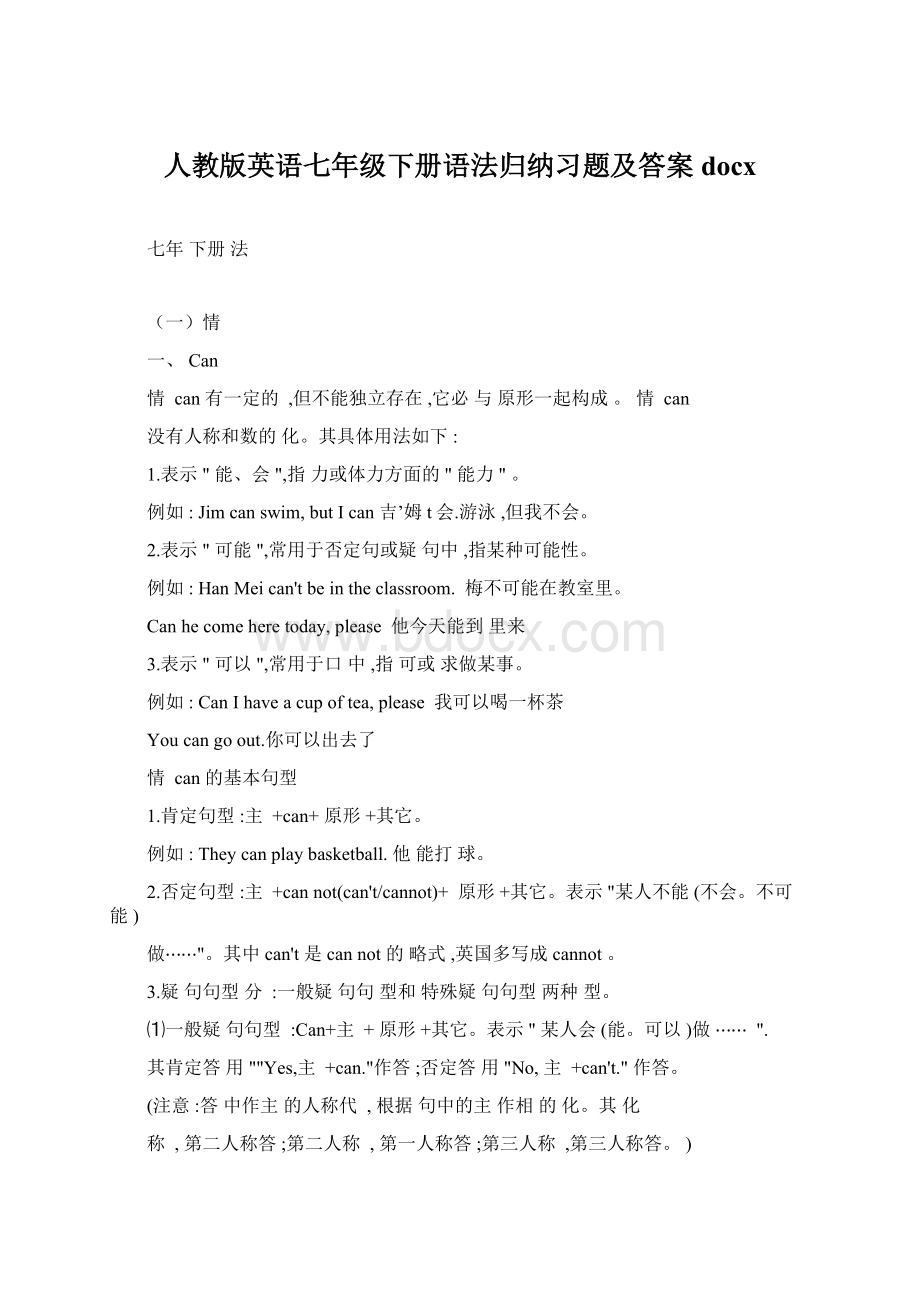人教版英语七年级下册语法归纳习题及答案docx.docx
《人教版英语七年级下册语法归纳习题及答案docx.docx》由会员分享,可在线阅读,更多相关《人教版英语七年级下册语法归纳习题及答案docx.docx(36页珍藏版)》请在冰豆网上搜索。

人教版英语七年级下册语法归纳习题及答案docx
七年下册法
(一)情
一、Can
情can有一定的,但不能独立存在,它必与原形一起构成。
情can
没有人称和数的化。
其具体用法如下:
1.表示"能、会",指力或体力方面的"能力"。
例如:
Jimcanswim,butIcan吉’姆t会.游泳,但我不会。
2.表示"可能",常用于否定句或疑句中,指某种可能性。
例如:
HanMeican'tbeintheclassroom.梅不可能在教室里。
Canhecomeheretoday,please他今天能到里来
3.表示"可以",常用于口中,指可或求做某事。
例如:
CanIhaveacupoftea,please我可以喝一杯茶
Youcangoout.你可以出去了
情can的基本句型
1.肯定句型:
主+can+原形+其它。
例如:
Theycanplaybasketball.他能打球。
2.否定句型:
主+cannot(can't/cannot)+原形+其它。
表示"某人不能(不会。
不可能)
做⋯⋯"。
其中can't是cannot的略式,英国多写成cannot。
3.疑句句型分:
一般疑句句型和特殊疑句句型两种型。
⑴一般疑句句型:
Can+主+原形+其它。
表示"某人会(能。
可以)做⋯⋯".
其肯定答用""Yes,主+can."作答;否定答用"No,主+can't."作答。
(注意:
答中作主的人称代,根据句中的主作相的化。
其化
称,第二人称答;第二人称,第一人称答;第三人称,第三人称答。
)
:
第一人
例如:
①
-CanyousinganEnglishsongforus你可以我大家唱一首英歌
-Yes.行。
(注意在
Yes后面常省略
Ican)
②-CanIskate我可以滑冰
-Yes,youcan.可以。
③
-Cansheclimbhills
她能爬山
-No,shecan't.不,她不能。
拓展:
⑵特殊疑句句型
:
a.Who+can+原形
+其它。
句型中
who
相当于主。
例如:
-WhocansinginEnglishinyourclass
你班上会用英唱歌
-Lilycan.莉莉会。
b.特殊疑问词(作定语)+名词+can+主语+动词原形+其它。
该句型中的特殊疑问词常用how
many,howmuch等。
例如:
-Howmanyboatscanyouseeintheriver
你能看见河中有多少只船吗
-Onlyoneboat.仅有一只。
c.特殊疑问词+can+主语+动词原形+其它。
该句型中的特殊疑问词常用what,where,when
等,
一般用肯定陈述句作答。
例如:
-Whatcanyouseeinthepicture
你能在图画中看到什么
-Icanseesomebirdsandtwobigtreesinit.我能看到一些鸟儿和两棵大树。
(中考模拟
)—Look!
Someoneiscuttingatreeonthemoon.
—It
betrue,Granny.Mumsaysthereisnoairthere.
A.can’t
B.mustn’t
C.may
D.should
解析:
根据thereisnoairthere判断出月亮上根本不可能有人在砍树,所以表示不可能。
答
案选A。
(中考模拟)Theboycanplay______chesswell,buthecan
’tplay______piano.
;the
;/
C./;the
D./;/
解析:
play后面跟表示球类(运动)的名词时,中间不用冠词
the;而跟表示乐器的名词时,
中间应用定冠词the。
答案为C。
按要求改写句子。
canrunfast.
I________________fast.(否定句)
canplaybasketballwell.(一般疑问句)
_______he______basketballwell
canplaytheviolin.(变成一般疑问句)
________she_________theviolin
can’tsing.Theycan’合tdance并成一.句()
They__________sing______dance.
5.Shecansinganddance.(否定句)
She___________sing____________dance.
keys:
not;;play;3.Can;play;
二、wouldlike的用法
’t;or;5can
’t;or
wouldlike用来表达意愿,意“想要”,相当于want,用法亦同want,但比want委婉。
would
是情,没有人称和数的化,可与人称代写’d,与其它情一可帮助完
成疑句和否定句。
用法:
1)
后接名或代,表示具体
“要”某西
want/wouldlikesth.想要某物
I’dlikesomenoodles
2)want/wouldliketodosth.想要做某事,常用于有礼貌的提出邀、求或建。
I’dliketoplaythepiano我想要琴。
3)want/wouldlikesb.todosth.想要某人做某事
Iwouldlikehimtohelpme.我想要他帮助我。
4)wouldyoulikesome⋯⋯你想要一些⋯⋯(委婉地方的要求的用)
句型常用于征求方意。
特注意句型中要用some,而不用any,以表示
人希望得到肯定回答。
肯定回答:
Yes,please.
否定回答:
No,thanks.
5)Wouldyouliketodosth你想要/愿意做某事(向方有礼貌地提出建或邀)句型中like可以成love。
肯定回答:
Yes,I’dlike/loveto是.的,我愿意。
否定回答:
Sorry,+原因。
或I’dloveto,but⋯⋯
Wouldyouliketogoshoppingwithus你想要/愿意和我一起去物
Yes,I’dlike/loveto是.的,我愿意。
Sorry,Ihavealotofhomeworktodo.不起,我有很多作要写。
I’dloveto,butIamtoobusy我.非常愿意,但是我太忙了。
:
1.----TimandIwillvisittheexhibition(展)thisweekend.Wouldyouliketojoinus
----______
A.Welldone.B.that’sright.C.you’rewelcome.D.I’dloveto.
2.----Wouldyoulikesomemilk
----______
A.Yes,please.B.Thesametoyou.C.Helpyourself.D.Mypleasure.
3.----Wouldyoulikesomemorerice
----______.Ieattoomuch.
A.No,thanksB.Yes,thankyouC.I’dlovetoD.Yes,please
4.Shewouldlikehermother______totheparkwithheronSunday.
A.togoB.goC.goingD.goes
westayathomewatchingTVtonight
---No.I’dlike_____andseeafilm.go
(二)集
一、一般在
一般在:
表示通常性、律性、性的状或者作。
志:
always,usually,often,sometimes,never,everyday/night/
⋯inthemorning⋯on
weekends⋯
主是第三人称数
主不是第三人称数
肯定句
主+s+其他
主+原形+其他
否定句
主+doesn't+原形+其他
主+don't+原形+其他
一般疑句
Does+主+原形+其他
Do+主+原形+其他
第三人称数的构成:
(用于第三人称数、
可数名的数和不可数名的一般在
中)
1、直接加—s:
look—looks
read—reads
play—plays
stop—stops
2.在字母
s,x,ch,sh,o后加—es:
miss—misses
fix—fixes
watch—watches
wash—washes
go—goes
do--does
3.辅音字母加
y结尾的动词变
y为
i,再加
-es:
carry–carries
study–studies
hurry–hurries
cry–cries
4.特殊的
have
–has
练习
1.(浙江省)Ilikesoftandgentlemusic.It______nice.
AissoundedBsoundedCsoundsDsounding
2---Canyourfatherdrive
-----Yes,he______toworkeveryday
A.isdrivingwritten
likesplayingsoccerverymuchandhe_____aboutonehourplayingiteveryday.
A.spentB.willspendC.hasspentD.Spends
Billisn'trichenough,heoften______moneytothepoor.
A.willgiveB.wasgivingC.givesD.Gave
5.Weoften___________(play)intheplayground.
6.__________you_________(brush)yourteetheverymorning.
7.What________(do)heusually_______(do)afterschool?
8.Mikesometimes__________(go)totheparkwithhissister.
keys:
5play;brush;7.does;do;
二、现在进行时
1.表示说话时正在发生或者进行
的动作
Pleasedon
’tmakesomuchnoise,I
’mstudying.
Let
’sgetout.Itisn
’traininganymore.
2.表示在现在相对较长一段时间内正在进行的动作,但是说话一刻不一定在做的动作
HaveyouheardaboutTomHeisbuildinghisownhouse.
DavidisteachingEnglishandlearningChineseinBeijing.
这些动作,在说话时并不一定在发生或进行,而是在包括说话的一刹那在内的一段时间内发
生、进行的.
现在进行时的时间状语主要有:
now,thesedays(目前),thisweek,atthemoment(此刻)
等,有时句首有“Look!
”、“Listen!
”或“It’时s+刻”等词、句存在。
肯定句:
主语否定句:
主语
+be+现在分词(主语在前
+be+not+现在分词
be
在后,现在分词跟着走。
)
一般疑问句:
be+主语+现在分词
特殊疑问句:
特殊疑问词+be+主语+现在分词+其他
动词现在分词的变化见下表:
词尾情况变化方式例词
一般情况加—ingplay玩—playing
see看见—seeing
sing唱—singing
do做—doinggo去—going
jump跳—jumping
ski滑雪—skiing
以不发音的e结尾去e加—ingmake做—makingtake拿到—taking
dance跳舞—dancinglike喜欢—likingcome来—coming
write写—writinghave有—havingclose关—closing
以重读闭音节结尾的动双写最后一
词,中间只有一个元音个辅音字母
字母,词尾只有一个辅再加—ing音字母
练习:
swim游泳—swimmingsit坐—sitting
begin开始—beginningrun跑—running
get得到—gettingput放—putting
jog慢跑—jogging
1.Listen!
They________inthenextroom.
A.singB.issingingC.aresingingD.weresinging
2.Iteight’so’clockThe.students______anEnglishclass.
A.haveB.havingC.ishavingD.arehaving
3.---Mary,couldyouhelpme
---Waitamoment.I_____.
A.readabookB.didmyhomework
C.waswatchingTVD.amcookingdinner.
4.Lookatthe_____!
It's_______heavilynow.
A.rain;rainB.raining;raining
C.rain;rainingD.raining;rainy
_______aChineseclasstoday.They________anEnglishclassnow.
A.aren'thaving;arehaving
B.don'thave;have
C.aren'thaving;have
D.don'thave;arehaving
三、一般过去时
1.一般过去时表示过去
(1)表示过去发生的动作或存在的状态:
Heboughtthecomputerfiveyearsago.这电脑是他五年前买的。
Itwasthenasmallfishingvillage.那时它只是一个小渔村。
(2)表示过去经常性或习惯性的动作:
Weoftenplayedtogetherwhenwewerechildren.我们小时候常在一起玩。
注:
表过去习惯性的动词,也可用usedto或would:
Heusedtogotoworkbybus.他过去常乘公共汽车去上班。
2.时间状语
与一般过去时连用的时间状语有:
yesterday(昨天),lastnight(昨晚),lastweek(上个星期),fourdaysago(四天前),in2002(在2002年),justnow(刚才),thedaybeforeyesterday(前天)等。
如:
Hewenttotheparkyesterday.她昨天去了花园。
Iwastenyearsoldin2001.我2001年才10岁。
3.一般过去时态的形式
动词在一般过去时中的变化:
⑴am和is在一般过去时中变为was。
(wasnot=wasn't)
⑵are在一般过去时中变为were。
(werenot=weren't)
⑶带有
was或
were
的句子,其否定、疑问的变化和
is,am,are
一样,即否定句在
was
或
were
后加
not,一般疑问句把
was
或were
调到句首。
2.句中没有
be
动词的一般过去时的句子
否定句:
didn't+动词原形,
如:
Jimwenthomeyesterday.
Jimdidn'tgohomeyesterday.
一般疑问句:
在句首加did,句子中的动词过去式变回原形。
如:
Jimwenthomeyesterday.
DidJimgohomeyesterday
特殊疑问句:
疑问词+一般疑问句
如:
Jimwenthomeyesterday.
DidJimgohomeyesterday
WhatdidJimdoyesterday
4.动词的过去式
一般过去时的谓语动词要用动词的过去式。
动词过去式的构成分规则变化和不规则变化
两种形式,不规则变化通常需要逐个记忆,规则变化则遵循以下原则:
(1)一般在动词后加-ed。
如:
play—played,offer—offered,weigh—weighed,
destroy—destroyed,sign—signed.
(2)在以字母e结尾的动词后,只加-d。
如:
like—liked,provide—provided,hate—hated,
date—dated。
(3)在以“辅音字母+y”结尾的动词后,则改y为i,再加—ed。
如:
supply—supplied,fly—flied,
study—studied.(from在以重读闭音节结尾且,末尾只有一个辅音字母的动词后,双写最后
一个辅音字母,再加-ed。
如:
plan—planned,refer—referred,regret—regretted,ban—banned.我们还学过许多不规则动词的过去式形式。
如:
am–was,are–were,put–put,see–saw,eat–ate等练习:
1.请写出下列动词的过去式。
want
is
_
arrive
see
_
enjoy
are_
shop
eat
2.单项选择。
1)—Nancyisnotcomingtonight.
—Butshe______!
A.promisesB.promisedC.willpromise
2)Timalways_____apictureathome.He_____acarnow.
A.draws;isdrawingB.draw;draw
C.draws;drawD.draw;isdrawing
D.hadpromised
3)IthoughtJimwouldsaysomethingabouthisschoolreport,buthe______it.
A.doesn’tmentionB.hadn’tmentioned
C.didn’tmentionD.hasn’tmentioned
4)I______younottomovemydictionary—-nowIcan’tfindit.
A.askedB.askC.wasaskingD.hadasked
5)Akid______breakfasteverymorning,becauseit’sgoodforhishealth.
A.havetoB.hastoC.hastohaveD.hastohas
6)——Where’sthecakeImadethismorning
——We_______it,mum.Canyoumakeanotheroneforus
A.ateB.eatC.willitD.wereeating
7)Look!
Twocats______acrossthewall.
A.runB.r